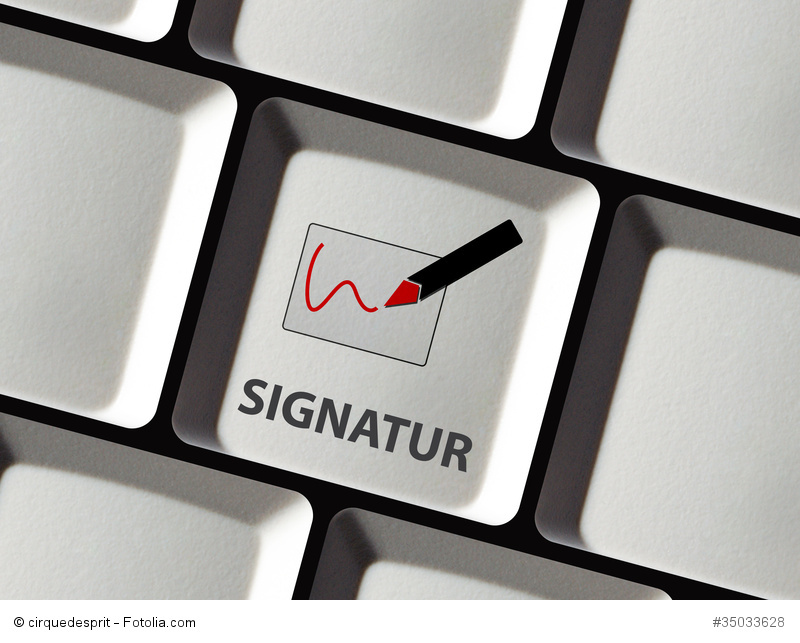Everything you need to know about the electronic signature
For all documents that require a signature, you need a corresponding substitute for the digital equivalent, i.e. an electronic signature (sometimes also called an e-signature).
You can compare advanced electronic signatures to a kind of seal. Digital documents can be secured in this way. This means that you can check the authenticity of the person signing (signature can be clearly assigned to a person) and the integrity of the document. It is ensured that the document has not been manipulated subsequently.
Optimise work processes through electronic signatures
Since many processes can be carried out completely digitally through the use of such an electronic signature, one has the opportunity to save significantly on time and resources (the signatory does not have to be physically present and printing is not necessary).
In addition, there are processes where a large number of documents have to be signed or where there are several signatories. Here, signatures offer a lot of potential to save time and costs.
Electronic signature vs. digital signature
Note: As there are country-specific and therefore linguistic differences, we refer here to the e-signature in Germany.
First of all, a distinction must be made between electronic and digital signatures, as the two terms are usually used synonymously. As soon as an electronic signature is mentioned, it is a legal term. An electronic signature is used concretely like a hand signature, for example to sign contracts. However, it does not have a visual appearance (as with a hand signature), as it only consists of a set of electronic data. This in turn makes it possible for a PDF to become verifiably authentic.
In contrast, a digital signature is a cryptographic process in which an electronic signature is created using a secret signature key. This allows the recipient to verify the signature with the associated public key. Furthermore, one must consider three important gradations when working with electronic signatures:
The three types of electronic signatures
One usually speaks of SES (simple electronic signature), AES (advanced electronic signature) or QES (qualified electronic signature). These 3 forms of signature differ in their legal “weight” and have different areas of application:
| SES – simple electronic signature | AES – advanced electronic signature | QES – qualified electronic signature | |
| Differences | Simplest form (basic level) Image/scan of the signature or a company seal or stamp – This solution is free of charge and possible for everyone Message or document which is additionally secured by an encryption technology | The signatory can be clearly identified and linked to the signature. – A suitable software is required | Secure form, absolutely legally binding advanced signature based on a qualified certificate valid at the time of its generation and created with a secure signature creation device (SSCD) Certificate as well as a signature card and a card reader mandatory. |
| How is the electronic signature created? | Digital signature or stamp is inserted. | An AES is usually created using an advanced certificate issued to a natural or legal person. Advanced means that it was issued by a legally recognised certification service (CA = Certificate Authority), with which the signatory must authenticate himself once. | The signature certificate of a QES must also be issued by a state-recognised certification service. In the case of a qualified signature, a time stamp can also be used to check whether the certificate was valid or not revoked at the time it was created. |
| Security level | Not sufficiently secure, as the digital signature in this form can be subsequently changed | Whether the signature is trustworthy beyond doubt can be checked electronically. Manipulations are recognisable. | Absolutely legally binding and equivalent to a handwritten signature. Due to the additional security level, a document signed with a QES is just as legally binding in all EU member states as a document with a handwritten signature. |
| Areas of application | Private or business e-mail with signature. Can be used for online applications, internal documents, all transactions with no or low legal risk. | For example, open-ended contracts, B2B commercial contracts or even automated mass signature of receipts, bank statements and business documents. Checking validity in the event of a dispute is simplified and is therefore suitable for transactions involving medium legal risk. | Notaries can make applications to the commercial register exclusively in this electronic way + Public procurement procedures and settlements of medical services rendered to statutory health insurants by panel doctors/registered doctors vis-à-vis the settlement office of the Association of Statutory Health Insurance Physicians. Or: registers of civil status at registry offices, certifications of births, marriages, deaths. Frequently also used by lawyers. |
More information about digital signatures with webPDF on our website:
https://www.webpdf.de/en/pdf-digital-sign-document
Information on securing documents with signatures:
Forms of signatures:
On encryption technology:
For use with webPDF:

